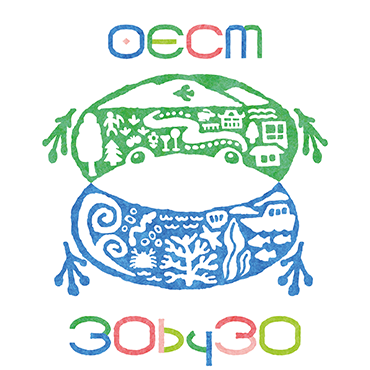Biodiversity
Basic approach
A wide variety of living organisms live on Earth, and it is said that these organisms are intricately intertwined to form ecosystems that are equipped with the ability to absorb various external changes and restore the environment to its original state. The Idemitsu Group aims to achieve the objectives of the Convention on Biological Diversity, and believes that an important mission for a company is to pass on this ecosystem to the next generation and maintain and restore the environment in which diverse organisms can continue to live.
We have formulated a plan to address the TNFD *1 recommendations over a four-year period starting from fiscal 2024 and are working on it. The LEAP Approach *2 that we are currently implementing is described in the "Strategy" section, and we will gradually expand disclosure of it.
In addition, even before the importance of biodiversity conservation became widely recognized in recent years, Idemitsu has always been conscious of coexistence with nature in the conduct of its business and has carried out its operations with consideration for this field. Sazo Idemitsu, the company's founder, advocated "the realization of a lush park-like factory where industry and nature coexist in harmony," with park-like green areas that would prosper together with the local community. To realize this philosophy, Idemitsu's Refinery and Complex have created green areas that exceed the legally required area when they began operations, striving for harmony with the surrounding natural environment. Biodiversity conservation activities promoted by Idemitsu, including these, are summarized in the "Initiatives" section.
-
Nature-related Financial Disclosure Task Force
-
Assessment methods for nature-related issues recommended in the TNFD recommendations
Policy
In the Idemitsu Group Sustainability Policy, our group outlines our efforts to reduce environmental risks arising from our business activities, to protect the natural environment, and to contribute to the realization of a recycling-oriented society. In addition, we are working to conserve biodiversity while building partnerships with local communities in accordance with the Biodiversity Guidelines described below.
Biodiversity guideline
We continue our business activities while utilizing the natural environment (natural capital)
consisting of land, water, air, and ecosystems including a wide variety of species and genes.
The importance of passing on the natural environment (natural capital), which is the foundation
of social activities, to future generations in an appropriate manner is a value that we have cherished
until now. Idemitsu Group Sustainability Policy clearly states that we will contribute to the
preservation of the natural environment and the realization of a circular society by reducing
environmental risks from our business activities.
This guideline is established as a supplement to the Idemitsu Group Sustainability Policy and as
a guideline for further conservation activities in the field of biodiversity included in the natural
environment (natural capital).
・We will accurately grasp the impact of our business activities on biodiversity and strive to
reduce negative impacts and increase positive impacts.
・When considering new businesses, we will fully consider the impact from the perspective of
biodiversity.
・We will contribute to the restoration of ecosystems whose biodiversity has deteriorated.
・We will contribute to the expansion of ecosystems where biodiversity is conserved.
・We will promote environmental education and awareness of biodiversity.
・We will strengthen disclosure of initiatives related to biodiversity conservation and expand
dialogue and cooperation with stakeholders.
Strategy
Assessing nature-related dependencies, impacts, risks and opportunities through the LEAP approach
We are assessing nature-related dependencies, impacts, risks, and opportunities using the LEAP approach recommended by the TNFD. We will disclose our implementation status in due course.
● LEAP Approach Implementation Plan



-
The program will be implemented for Petroleum and coal businesses (direct operations) in FY2024, and will be expanded to include more businesses in FY2025.
Selection of businesses to be analyzed
As an initial assessment, we used ENCORE *, an online tool that can analyze the dependency on and impact on nature for each business process, to understand the points of contact between our Group's businesses and nature. In terms of dependency on nature, the following businesses were assessed as having an importance level of "High" or higher: crude oil transportation, coal mining, thermal power generation, solar power generation, wind power generation, biomass power generation, geothermal power generation, Advanced materials & Performance Chemicals manufacturing. In terms of impact, all businesses had items rated as having an importance level of "High" or higher, confirming that our Group's businesses have a deep connection with nature.
Considering these results and sales scale, we have recognized Petroleum business and coal business as high priority businesses and have begun an analysis using the LEAP approach. This time, the analysis was focused on direct operation bases, but in the future, we would like to consider analysis methods and expand the scope to upstream and downstream. In addition, since our group operates coal mines, the analysis this time includes coal mining at operating mines.
-
A tool jointly developed by the United Nations Environment Programme World Conservation Monitoring Centre (UNEP-WCMC) and financial institutions to assess the dependency and impact of business processes on nature
● Overview of our Group's business dependence on and impact on nature (ENCORE assessment results)



-
VH: Very High, H: High, M: Middle, L: Low, VL: Very Low
-
Evaluation results as of June 2024
Your connection with nature(Locate)
In order to identify sensitive locations that are considered to be ecologically sensitive, we analyzed the proximity to areas important for biodiversity and physical water risks. In terms of proximity to areas important for biodiversity, there are no sites close to IUCN protected areas of category Ia (strictly protected areas), Ib (wild wilderness areas), III (natural monuments), or World Heritage sites, but there are sites located within a 5km radius of IUCN protected areas of category II (national parks), Ramsar sites, and KBAs *1. In terms of physical water risks, no sites were assessed as having "High" or "Extremely High" water stress in the assessment using the Aqueduct Water Risk Atlas *2. We plan to select material locations with significant nature-related dependencies, impacts, risks, and opportunities based on the results of the Evaluate and Assess phases, and identify priority areas.
-
Key Biodiversity Area (Areas important for the conservation of biodiversity)
-
Water risk assessment tool developed by WRI (World Resources Institute)
● Overview of priority regions and implementation status



● Indicators and tools used to analyze sensitive locations
|
|
|
|---|---|
|
|
|
|
|
|
● Number of sites located near areas important for biodiversity (within a 5km radius)
| IUCN Categories | World Natural Heritage |
Ramsar Ramsar Convention Sites |
KBA | ||||
|---|---|---|---|---|---|---|---|
| Ⅰa | Ib | II | Ⅲ | ||||
|
Number of applicable locations (Number of analysis locations: 31) |
0 | 0 | 1 | 0 | 0 | 1 | 11 |
● Water stress assessment results
|
|
(<10%) |
(10-20%) |
(20-40%) |
(40-80%) |
(>80%) |
|---|---|---|---|---|---|
|
(Number of analysis locations: 31) |
|
|
|
|
|
Nature dependency and impacts and related initiatives(Evaluate)
In order to identify nature-related risks and opportunities, it is first necessary to understand the dependency and impact on nature. In the Evaluate phase, we first used ENCORE to organize the dependency and impact for each process. Next, we investigated the status of the processes and bases in which our group operates and identified the dependency and impact. We also organized the status of related initiatives.
● Steps for evaluation



-
For the use stage, see land transportation, air transportation, and water transportation for Petroleum business, and energy production from fossil fuels for coal business.
● Summary of the main nature dependency and impacts of each business
Petroleum Business
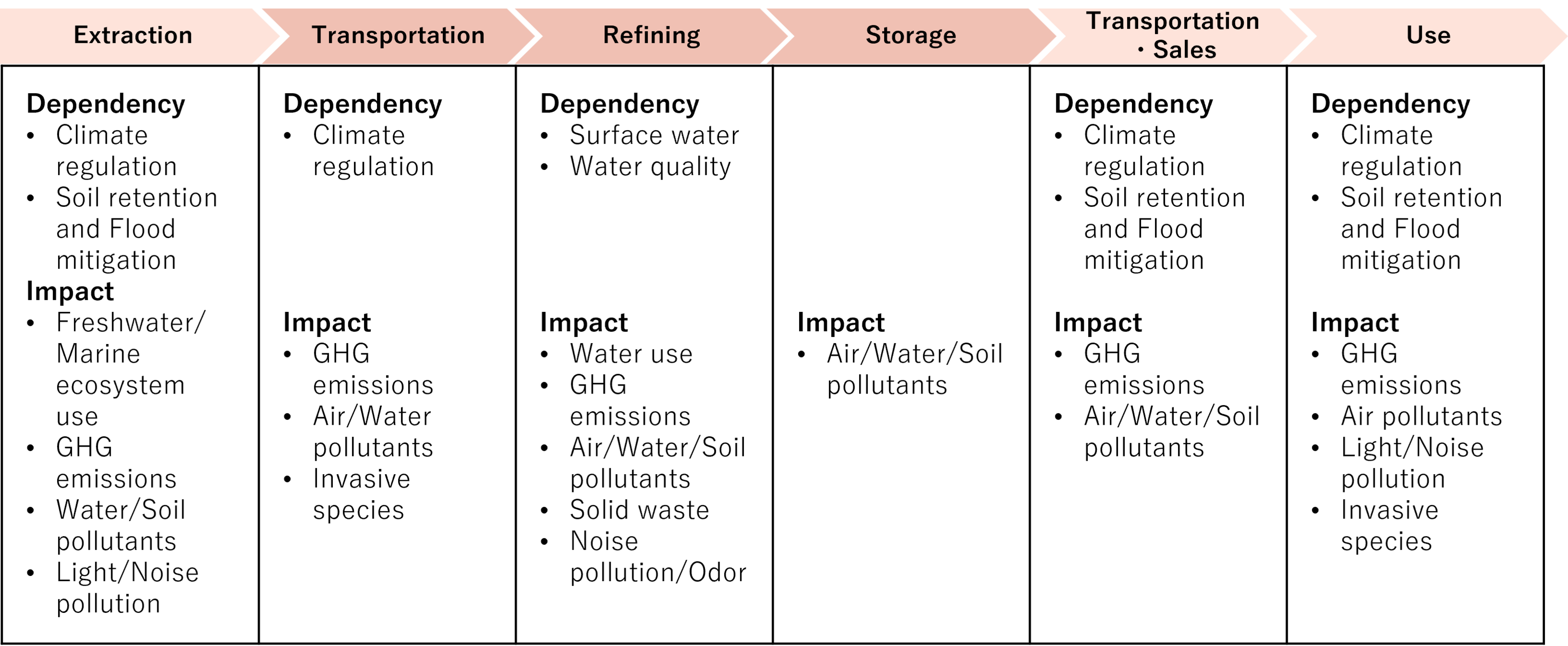


Coal Business



● Major initiatives related to each business
| Business | Process (Location) | Main initiatives |
|---|---|---|
| Petroleum | transportation |
・Prevention of ecosystem disruption caused by invasive species through ballast water, such as by introducing ballast water treatment equipment ・Prevention of marine pollution through oil spill accident countermeasures such as double-hulled vessels ・Reduction of air pollutant emissions through the introduction of exhaust gas recirculation systems and SOx scrubbers |
|
Petroleum refining (Refinery / Complex) |
・Reducing water usage through water recycling ・GHG reduction through operational and equipment improvements ・Prevention of water pollution by installing activated sludge treatment equipment, etc. ・Prevention of air pollution through the installation of flue gas desulfurization equipment, flue gas denitrification equipment, electric dust collectors, etc. ・Prevention of oil spills through regular piping inspections and installation of oil fences in case of oil spills ・Reduction of final disposal volume through waste recycling, etc. ・Prevention of noise by installing soundproof covers on noise-producing equipment ・Prevention of odors by cleaning and recovering gases that contain odor-causing substances |
|
|
storage (oil terminal) |
・Reducing VOC emissions by changing the structure of storage tanks from fixed roofs to floating lids and installing VOC recovery equipment ・Prevention of water pollution by installing oil-water separators, etc. ・Soil contamination survey based on the Soil Contamination Countermeasures Act |
|
| Coal |
Coal mining (Coal mine) |
We implement environmental impact management based on strict permits and management plans approved by state and federal governments. Specific key initiatives include the following: Rehabilitation *1 Restoration of former coal mining sites through ・Biodiversity offsets *2 ・Monitoring of groundwater levels, air pollutants, water pollutants, noise and vibration caused by excavation and blasting, etc. ・Engagement with the local community through holding community advisory committees, etc. ・Continuing information exchange and dialogue with Aboriginal communities through holding Aboriginal Stakeholder Consultation Forum meetings |
-
This is an activity to restore biodiversity by returning topsoil to land after mining has ended and planting the same types of plants as in the original state.
-
Measures taken to compensate for ecosystems and biodiversity lost due to mining
※詳細はLEAPアプローチ関連情報>事業の自然への依存とインパクト・関連する取り組みをご覧ください。
※GHGに関する取り組みについては、カーボンニュートラル、気候変動対応をご覧ください。
Looking ahead
Based on the dependency on nature, impacts, and related initiatives we have compiled, we will identify risks and opportunities, and if necessary, work to improve countermeasures and set targets. In addition, because it is important to have a bird's-eye view of the value chain when identifying dependency on nature, impacts, risks, and opportunities, and when implementing countermeasures, we will also consider analyzing upstream and downstream.
Risk management
Initiatives
Reducing the impact of business activities on nature
Preventing ecosystem disruption caused by invasive species transmitted via ballast water (Petroleum business)
We are working to prevent ecosystem disruption caused by invasive species in accordance with the Ballast Water Management Convention (International Convention for the Control and Management of Ships' Ballast Water and Sediments), an IMO guideline that came into force on September 8, 2017. All of Idemitsu Tanker Co., Ltd.'s managed ships (Very Large Crude Oil Carrier) are equipped with ballast water treatment systems that use electrolysis or filters and chemicals. In order not to disrupt the ecosystems of the waters around ports, the seawater loaded as ballast water when leaving port is treated with this treatment system to kill or remove harmful aquatic organisms and pathogens in the water.
-
Seawater stored on board large ships to balance them while they are sailing
Rehabilitation of coal mined sites (coal business)
Coal mining operations extract coal that is buried underground, and in the case of open pit mining, the topsoil is scraped away, at which point it has a negative impact on biodiversity. Therefore, we carry out activities (rehabilitation) to restore biodiversity by returning the topsoil after mining and planting the same types of plants as in the original state, thereby minimizing the impact on the surrounding environment. Our Australian coal mines disclose information such as the area they have excavated and the area they have rehabilitated, and we will continue to do so.
● Rehabilitation of mining sites
● Rehabilitation implementation status of Australian coal mining site (Bogabrai) (unit: ha)
|
|
|
|
|
|---|---|---|---|
|
|
|
|
|
|
|
|
|
|
|
|
|
|
|
|
|
|
|
|
|
|
|
|
|

2 years after rehabilitation

4 years have passed since rehabilitation

15 years have passed since rehabilitation

2 years after rehabilitation

4 years have passed since rehabilitation

15 years have passed since rehabilitation

2 years after rehabilitation

4 years have passed since rehabilitation

15 years have passed since rehabilitation
Biodiversity Conservation Activities
Our greening efforts, an activity that leads to the preservation of biodiversity, began with the construction of our first Refinery, Tokuyama Refinery (now Tokuyama Complex), which was completed in 1957. At the time, the Factory Location Law and other regulations and laws concerning factory green spaces were not enforced, but the founder Sazo Idemitsu believed that it was necessary to create a factory that would be loved by the public, and he advocated the creation of a lush green park factory where industry and nature would blend together, and a large green space with a Western-style garden was created at Tokuyama Refinery. The founder's thoughts were later carried over to Refinery and Complex, which were built in various locations, and green space-related activities continue to this day.
In addition, we believe that it is important to work with local communities to conserve biodiversity from the perspective of coexisting with local nature, and we are working with other organizations in various regions to achieve this goal. Major biodiversity-related activities are as follows
● Major biodiversity-related activities
|
|
|
engagement |
|
|
|---|---|---|---|---|
|
|
|
|
|
|
|
|
|
|
|
|
|
|
|
|
|
|
|
|
|
|
|
|
|
|
|
|
|
|
-
The Social and Environmental Green Evaluation System (SEGES) is run by the Urban Green Infrastructure Management Organization, a public interest incorporated foundation.
-
Toward the realization of the 30by30 initiative, the government (Ministry of the Environment) will certify areas where biodiversity conservation efforts are being made through private initiatives as "nature coexistence sites."
-
Registered as "Chita Peninsula Green Belt" together with surrounding businesses
[Green space management]
Monitoring of plants and animals living in green spaces on the premises (Hokkaido Refinery)
Hokkaido Refinery has created a buffer green space after much trial and error, building sacrificial forests and artificial hills, and installing salt damage fences in the harsh environmental conditions unique to Tomakomai, such as sea breezes and volcanic ash. Approximately 12,000 trees, including rowan, birch, and black pine, are grown there. Currently, it also functions as a habitat for living creatures, and surveys of plants, dragonflies, birds, and shellfish have been conducted since 2012. Bird song monitoring and migratory bird monitoring, which have been conducted every three years since 2016, have shown that the diversity of birds living in the green space of Hokkaido Refinery has been largely maintained, and that the green space of Refinery has become a permanent migratory route for small birds. Please see the next page for details.
Improvement activities for the "Local Forest" green space on the premises (Chiba Complex)
Refinery (currently Chiba Complex) established and maintained a green belt 100m wide and 3km long at the same time it began operations in 1963. In addition, in order to create a local evergreen broadleaf forest known as the "Local Forest," the planting of non-native species of trees that had been planted on the premises since the plant began operations has been carried out since 2011 with plants native to Japan (especially the Boso Peninsula). In 2011, non-native species such as Chinese walnut, which had overwhelmed other tree species, were systematically cut down, and a total of 100 trees, including Machilus thunbergii, Castanopsis sieboldii, Chinese hackberry, and Hazenoki, which are commonly found in natural forests along the coast of Chiba Prefecture, were then planted. Since then, management of the branches of upper-story trees that overwhelm the planted trees has been continued, and by 2023, the planted trees have grown steadily and the shrubs of the natural forest have grown. From 2022 onwards, the target area will be expanded and improvements to the green space will be implemented.
Protecting the rare species "Mizo Koju" (Aichi Complex)
When installing new equipment at Refineries / Complexes, we conduct environmental assessments and protect rare plants identified through ecosystem surveys. Currently, the rare plant ''Mizokoju'' (designated as a near-threatened species by the Ministry of the Environment), which was discovered during the construction of equipment at Aichi Complex is protected in a protected area.
"Activities to protect and nurture the grasslands of Akiyoshidai" (Sanyo Onoda Plant, Seibu Oil Complex, Ltd.)
As part of our efforts to protect the water source of "Akiyoshidai," we are taking part in a collaborative water source conservation activity called "Activities to Protect and Cultivate the Grasslands of Akiyoshidai," organized by the Kotogawa Industrial Water Users Council (a voluntary organization consisting of 12 companies that draw industrial water from the Kotogawa River).
As supporters of activities such as "fire cut" which is important for maintaining the grasslands of Akiyoshidai, we are involved in conservation activities every year leading up to the "mountain burning" which is a seasonal event in early spring.
[Engagement with local communities]
Hosting of the nature experience event "Idemitsu Living Creatures Research Team" (Hokkaido Refinery)
With the aim of passing on the preservation of biodiversity to future generations, we have been holding the "Idemitsu Living Creatures Research Team" nature experience event for elementary school students since 2014, focusing on the flora and fauna that live in the green spaces on our premises. Please see the next page for details.
Double cherry blossoms on Refinery open to the public (Hokkaido Refinery)
Within Hokkaido Refinery, a row of approximately 80 double cherry blossom trees is planted over a distance of approximately 800m, and is open to the public when in full bloom.
[Collaboration with other organizations]
Participation in the "Corporate Forest" System (Hokkaido Refinery)
Since December 1996, Hokkaido Refinery has been using the Forestry Agency's "Corporate Forest" system, which allows corporations and other corporations to participate in the maintenance of national forests and carry out social and environmental contribution activities. The forest is managed under the name "Idemitsu Appenai Water Source Forest."
In May 2008, we newly leased 4.5 hectares of land in Tomakomai City for reforestation, and in June of the following year, we invited 102 elementary school students in the city to participate in a hands-on learning experience in planting trees such as red spruce, white birch, and double cherry tree. We planted 6,500 trees. This forest has been named the ''Idemitsu Green Natural Forest,'' which was chosen by elementary school students who participated in the tree-planting project, and will be maintained.

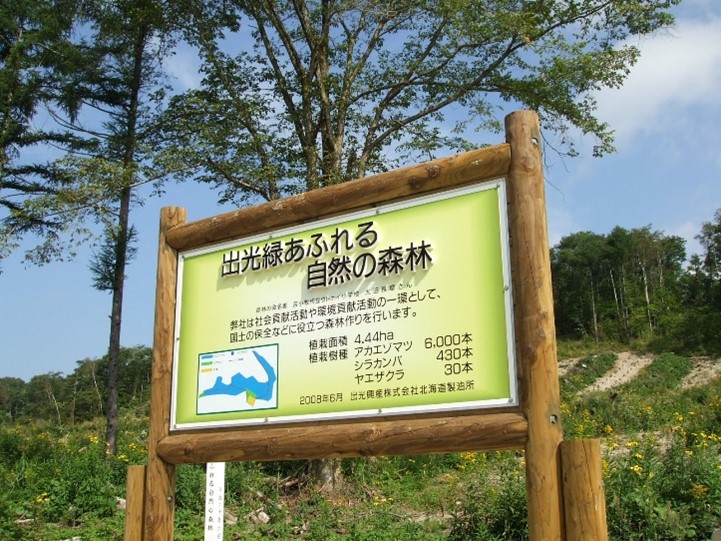




Participation in "Haskap Bank" (Hokkaido Refinery)
Hokkaido Refinery is working with the local community to protect, preserve, and cultivate the haskap Resources that is native to Tomakomai, as well as to acquire and improve related technology through its participation in the Haskap Bank.

Haskap (Tomakomai native species)

Idemitsu Hascup Garden

Haskap (Tomakomai native species)

Idemitsu Hascup Garden

Haskap (Tomakomai native species)

Idemitsu Hascup Garden
Participation in the "Corporate Forest Project" (Chiba Complex)
Chiba Complex has signed an agreement with Chiba Prefecture on the "Corporate Forest Project" and will be carrying out forest maintenance as "Idemitsu Chiba Forest" from fiscal year 2024. This initiative contributes to the local community by having the company carry out forest maintenance on behalf of Chiba Prefecture in prefectural forests. In addition, we plan to utilize a system in the future in which the prefectural governor evaluates and certifies the amount of CO2 absorbed by forests. In 2024, we carried out three conservation activities (grass cutting, repairing a promenade that was damaged by a major typhoon several years ago, etc.).
Participating in the "Connecting Lives Project" (Aichi Complex)
Aichi Complex is active as a key member of the "Connecting Lives Project" *1, which aims to improve biodiversity and promote the formation of ecosystem networks. In fiscal 2024, we participated in the project's event, "LOVE GREEN DAY 2024."
This project was highly praised for its potential as a prototype for initiatives that contribute to biodiversity in buffer green zones and for being a social framework that continues from COP10 (2010). In October 2024, it received the Prime Minister's Award, the highest award, at the 44th Green City Awards *2.
-
"Connecting Lives Project": An initiative by Aichi Prefecture government, companies, university students, and experts with the goal of increasing greenery and creating an environment where living things can live comfortably.
-
The award is organized by the Urban Landscape Infrastructure Foundation, a public interest incorporated foundation, and is given to recognize civic groups, companies, public organizations, and others that have made pioneering and proactive efforts to improve the environment, enhance the landscape, and revitalize local communities through the use of greenery, and have achieved good results, with the aim of promoting the creation of greener cities.

LOVE GREEN DAY 2024


LOVE GREEN DAY 2024


LOVE GREEN DAY 2024

Participating in volunteer work to maintain crane roosts (Tokuyama Complex)
Every year, Tokuyama Complex participates in and cooperates with the volunteer activities for "creating a crane roost" promoted by Shunan City to protect the Hooded Crane, a species designated as endangered in the second category, which migrates to the Yatsushiro area of Shunan City around the end of October.
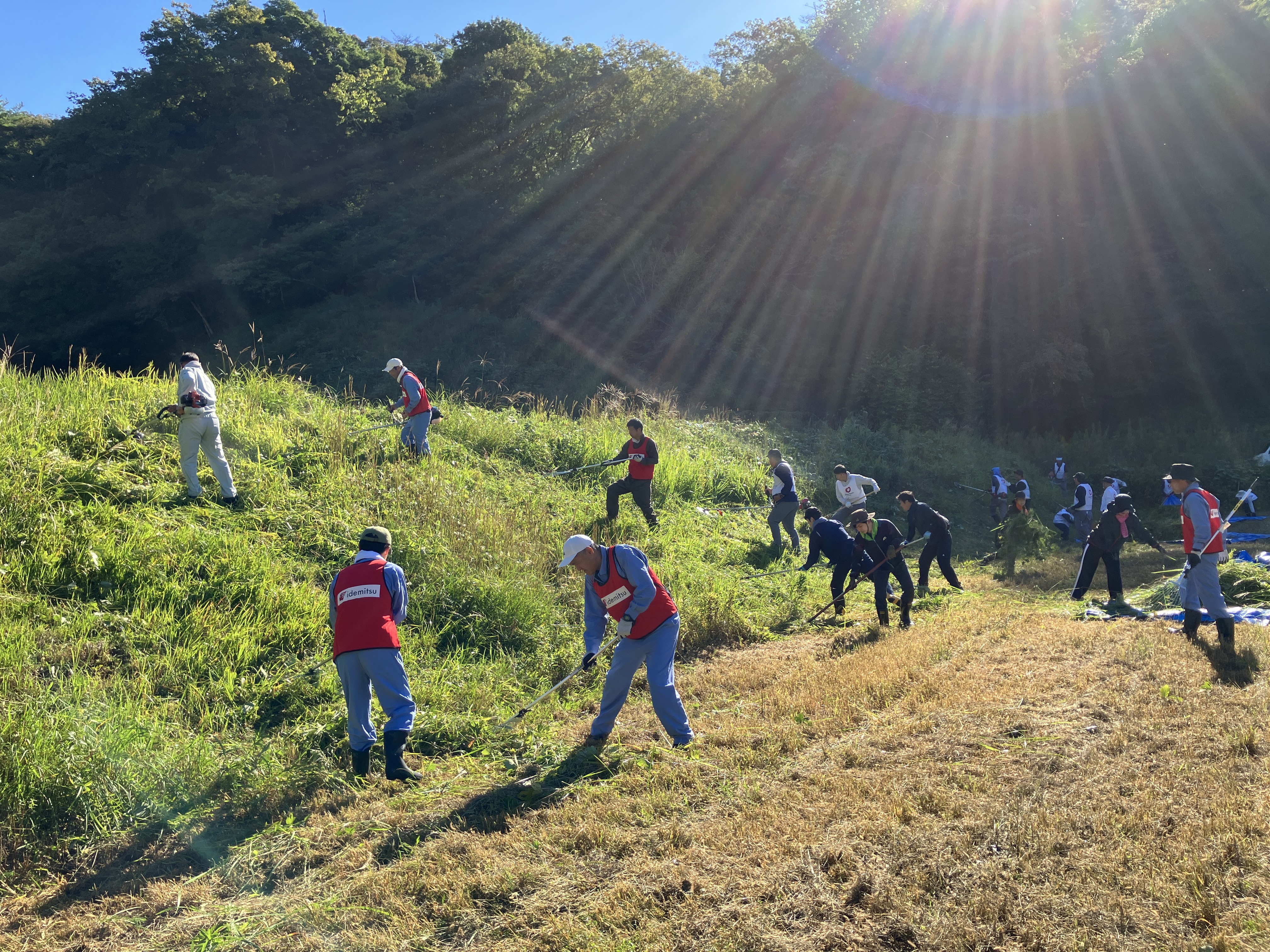
“Creating a roost for cranes”

“Creating a roost for cranes”

“Creating a roost for cranes”
Participating in the "Town, Forest and Water Exchange Event" (Tokuyama Complex)
The "Town, Forest and Water Exchange Meeting" hosted by the Shunan Agriculture, Forestry and Fisheries Office aims to deepen understanding of the water source conservation and global warming prevention functions of forests, which are essential to the lives and business activities of the prefecture's residents, as well as to promote voluntary activities for forest development and appropriate management.The event involves the development of water source forests with the wide participation of water-using companies and others.
Our company, which is a member of the Industrial Water Users Council and uses water, is also participating in this activity.
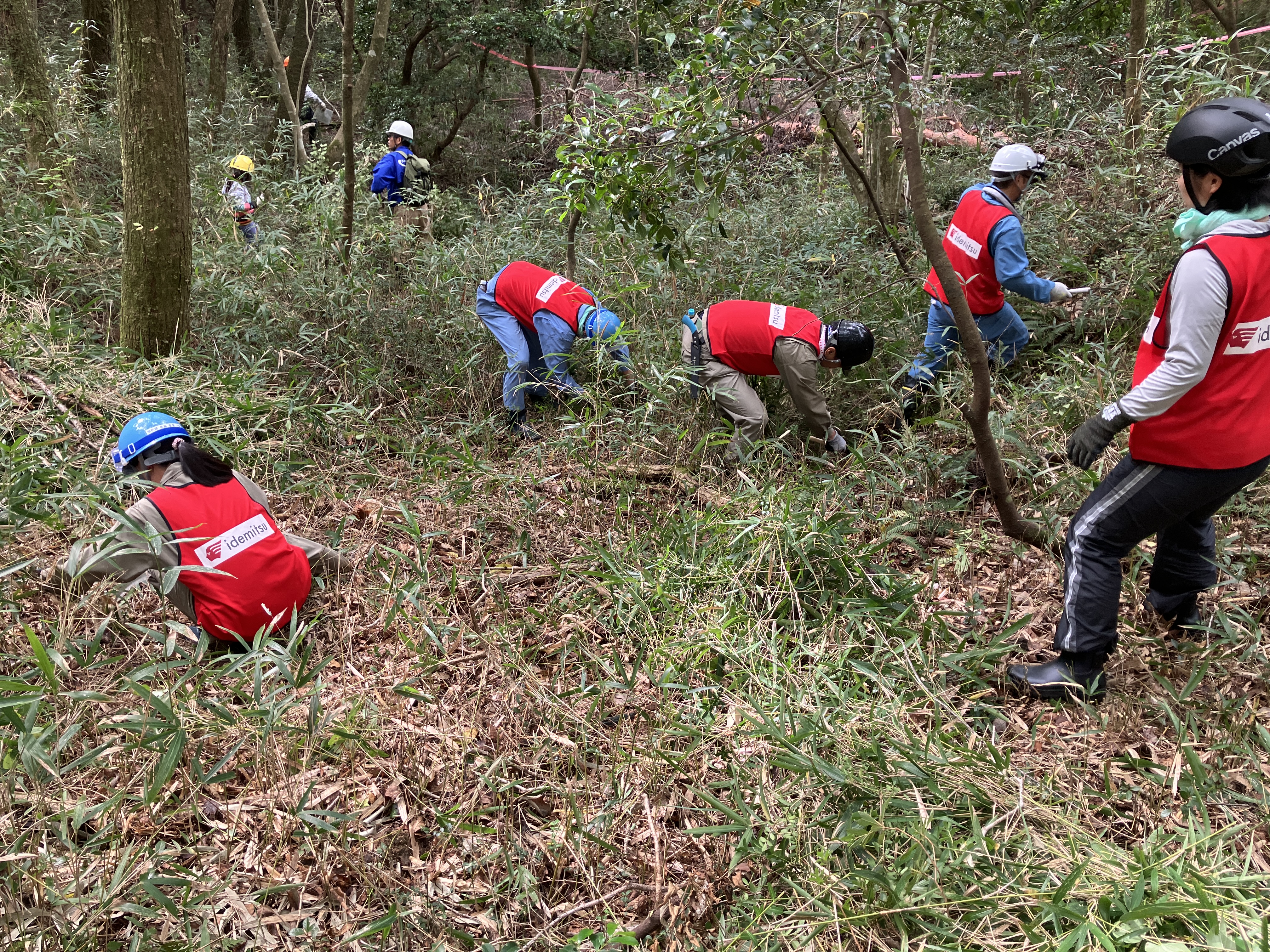
Scenes from the "Town, Forest and Water Exchange Meeting"

Scenes from the "Town, Forest and Water Exchange Meeting"

Scenes from the "Town, Forest and Water Exchange Meeting"
Participating in the initiative
Participation in the 30by30 Alliance
In order to achieve the goals of 30by30 *, we have been participating in the 30by30 Alliance for Biodiversity, which is composed of the Ministry of the Environment (secretariat) and interested companies, local governments, and organizations, since its inception in April 2022.
-
30by30: A target to effectively conserve more than 30% of land and ocean ecosystems as healthy ecosystems by 2030, with the goal of halting and reversing biodiversity loss by 2030 (nature positive).
Clean Ocean Materials Alliance (CLOMA)
Shunan City, Yamaguchi Prefecture Wood Biomass Material Utilization Promotion Council
Evaluation
Obtained the highest ranking in the Social and Environmental Green Space Evaluation System (SEGES) (Hokkaido Refinery and Aichi Complex)
Our ecosystem conservation activities in the areas surrounding our Refineries/Complexes have been highly praised by external organizations, with our Hokkaido Refinery and Aichi Complex achieving the highest possible ranking (Superlative Stage) on a five-point scale in the Social and Environmental Green Evaluation System (SEGES) run by the Organization for Landscape and Urban Green Infrastructure.
Additionally, Aichi Complex has been certified with the highest SEGES rating since 2016, and in recognition of its significant contributions to enhancing the value of green space, it was certified as a "Green Hall of Fame" in 2023. Specifically, it has been highly praised for its efforts to restore the forest cycle within the green belt by clearing out invasive species, converting to native species, and creating canopy gaps, as well as its efforts to regenerate the ecosystem network in collaboration with government and students. This marks the 10th corporate green space in Japan to be certified as a "Green Hall of Fame," and the first for a Japanese Refinery.
Following this, Hokkaido Refinery was also certified as a "Green Hall of Fame" in 2025.
Since its inception, the plant has been working on greening activities within the harsh natural environment unique to Tomakomai, and has cultivated 20,000 trees to date, using various methods such as installing net fences and creating artificial hills to protect the trees from sea breezes and volcanic ash. Furthermore, the plant has been carefully cultivating a 200-meter-long row of double cherry blossom trees for over 50 years, which is open to the public in the spring. The plant also participates in conservation and cultivation activities for native haskap, a local specialty, and has opened part of its grounds to the local community as a cultivation garden. The plant also works to preserve its natural heritage, providing opportunities for elementary school students to learn about the importance of nature through environmental studies that focus on the flora and fauna of the plant site.
Going forward, we will continue our efforts to maintain and develop green spaces and contribute to the local natural environment.
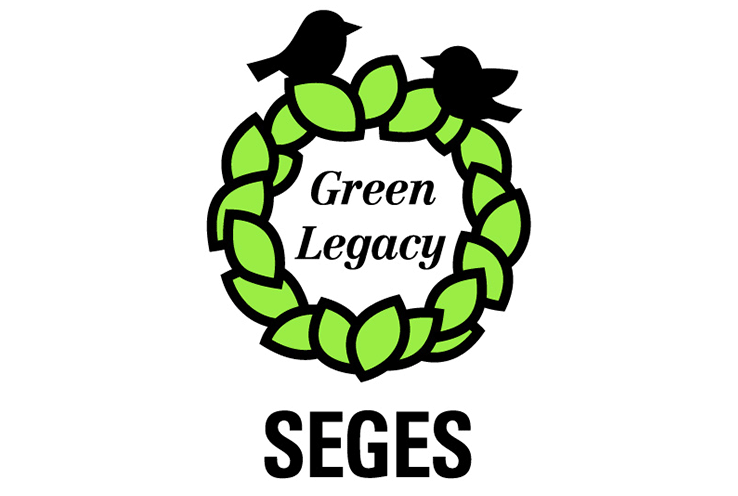

Green space at Aichi Complex


Green space at Aichi Complex


Green space at Aichi Complex

Planting double cherry blossoms
SEGES evaluation points
1. Permanence of land use: There is a system that allows greenery to exist and continue to exist.
2. Green space management: The process by which green spaces are created, protected, and nurtured is clear.
3. Demonstration of green space functions: Green spaces contribute to society and the environment.
4. The future potential of green spaces: There are ideas and attitudes regarding the form of green spaces that contribute to society and the environment, as well as the progressiveness and uniqueness of initiatives that drive the creation of a green society.



Certification as Nationally Certified Sustainably Managed Natural Sites (Hokkaido Refinery)
Towards the realization of 30 by 30, the country (Ministry of the Environment) is building a system in which areas where biodiversity is being conserved through private sector initiatives will be certified as "Nationally Certified Sustainably Managed Natural Sites". Hokkaido Refinery has been certified as a ”Nationally Certified Sustainably Managed Natural Sites” in 2023.
Since its launch in 1973 Hokkaido Refinery has been managing its green spaces in harmony with the surrounding natural environment with the aim of becoming a "green park factory," and now, 50 years into its operation, a forest has formed that is home to a diverse range of plants and animals. In the green spaces on the premises, the cherry blossom trees are open to the public, a nature experience event for elementary school students called the "Living Creatures Research Team" is held, and the refinery is involved in activities to contribute to the local community, such as participating in the conservation and cultivation of wild haskap trees.
The certified areas, excluding any overlap with protected areas, have been registered in an international database as "OECMs (areas other than protected areas that contribute to biodiversity conservation)."

